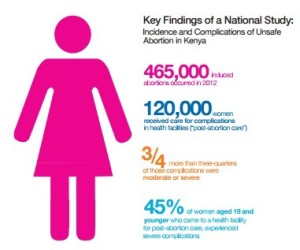Compiled by : Winnie Kamau
The persistence of unsafe abortion is a serious threat to the sexual and reproductive health and rights guaranteed to Kenyan women and men under the constitution enacted in 2010. Evidence from this nationally representative study should inform public dialogue and strengthen advocacy for safe abortion in Kenya, as well as delivery of safe services, within the confines of the law and in accordance with the constitution. Furthermore, improved access to comprehensive abortion care, including counseling and effective contraceptive access and use, will both save women’s lives and reduce costs to Kenya’s overburdened healthcare system.
In Kenya, unsafe abortion has long been recognized as a leading cause of death and injury to women—deaths and injuries that are preventable. Most abortions result from unintended pregnancies, which, as in most of Africa, continue to be extremely high throughout Kenya. A new national study undertaken in 2012 assessed the number of abortions annually in Kenya, the extent of unsafe abortion, the characteristics of women who seek abortion-related care in Kenyan health facilities and the quality of care available. In cooperation with the Kenyan Ministry of Health, the study was conducted in a large representative sample of 328 public and private health facilities across the nation, along with a survey of 124 health care professionals who are knowledgeable about issues of access to abortion care. National-level estimates and key findings regarding abortion in Kenya:
- Nearly 465,000 induced abortions occurred in 2012, translating to a high national abortion rate of 48 per 1,000 women of reproductive age (15- 49 years). This rate is comparable to Uganda’s, but much higher than other countries in Africa or elsewhere in the world. The rate is highest in the Rift Valley and Nyanza/Western regions (64 and 63 per 1000 women of reproductive age, respectively).
- Nearly 120,000 women received care for complications resulting from unsafe abortions in health facilities in 2012.
- More than three-quarters of women who were treated for post-abortion care had moderate or severe complications, including high fever, sepsis, shock, or organ failure, which can require extensive treatment or hospitalization. Delays in seeking care and reporting to the provider that they interfered with the continuation of their pregnancy were highly associated with the severity of complications.
- Young women suffered disproportionately, as 45% of women aged 19 and younger who came to a health facility for postabortion care, experienced severe complications.
- Kenya has a relatively high case-fatality rate of 266 deaths per 100,000 unsafe procedures. These deaths are almost entirely preventable. The World Health Organization (WHO) estimates the case-fatality rate in developed regions to be 30 per 100,000, compared to an estimated 460 deaths per 100,000 unsafe abortions on the African continent.
- Women who have abortions in Kenya are diverse—educated and non-educated, urban and rural, Christian and Muslim, married and unmarried, old and young.
- More than 70% of women seeking post-abortion care were not using a method of contraception prior to becoming pregnant. Similarly, the results of the most recent Demographic and Health Survey in Kenya (2008-2009) found that 43% of births in the preceding five years were reported by women as unwanted or mistimed, reflecting significant barriers to access and use of effective contraceptive methods.
- For most women reaching health facilities, methods of post-abortion care and induced abortion recommended by the World Health Organization were available and provided by trained providers. However, the continued use ofmethods that are not recommended—dilation and curettage (D&C) in particular—suggest that quality of care improvements are still much needed, as well as efforts to make women and communities aware that care is available and to remove barriers so that women in need of care reach facilities with minimal delays.
- Post-abortion care arising from unsafe abortion adds an extra strain on limited resources in an already overstretched healthcare system.
https://www.guttmacher.org/pubs/FB-abortion-in-Kenya-2013.pdf














